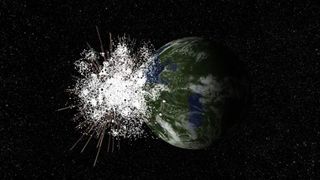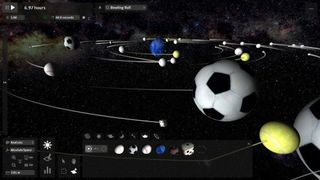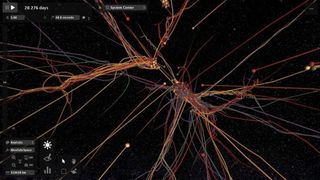Universe Sandbox: playing god in the interplanetary gravity simulator

This article originally appeared in issue 232 of PC Gamer UK.
I am become death, destroyer of worlds. I have exploded the Sun. I have exploded Venus, Mercury and Mars. I have exploded Saturn, and watched its rings and moons spiral off into interstellar space. I have, perhaps inevitably, exploded Uranus.
Universe Sandbox is more of a physics playground than a traditional 'game'. You set up a series of planetary bodies, adjusting the mass, diameter and density to your liking, and then hit 'Go' and watch what happens. If you've got it right, they'll orbit each other like a colossal galactic spirograph. If you've got it wrong, they'll collide and explode, hurling chunks of debris at incredible speeds out into the cold nothingness between stars.
Much more fun than generating your own solar system, however, is screwing around with already-existing ones. An enormous range of scenarios come baked in, and more are added frequently by the sim's active community of fans. These scenarios encompass everything from comets, already-known exoplanets, and large-scale galactic collisions, right through to the Death Star orbiting Endor, and a space elevator between the Earth and the Moon.

It gets even odder. One simulation puts a 7.2kg bowling ball in space, and has a series of footballs, tennis balls and dice orbiting around it at distances of tens of centimetres. It illustrates beautifully that gravity doesn't just apply to enormous planets – it has an effect on everything in the universe.
It raises the question of why sims like this aren't being used more in schools. Bringing teapots and footballs into play alongside colossal gas giants and asteroid belts could help kids visualise scenes that are difficult to conjure up in the imagination alone.
Away from the educational aspects of Universe Sandbox, I've been having the most fun just mucking around with our own humble solar system. I've given the Moon rings, and watched the Earth twist them into beautiful shapes. I've paused the orbit of Jupiter and watched it plunge into the Sun, then ricochet back out. I've tied a ridiculously strong rope between Mars and Venus, and seen one twirl the other into outer space like a ballerina.
PC Gamer Newsletter
Sign up to get the best content of the week, and great gaming deals, as picked by the editors.

I can't quite put my finger on what I get out of this sim. On the one hand, there's something beautiful and calming about watching a 570,000,000,000,000,000, 000,000 ton rock glide gracefully through the darkness of space. On the other, Universe Sandbox lets me hurl dice onto the surface of Mercury, for future exo-archaeologists to puzzle over.
Now if you'll excuse me, I need to see what happens when you make Earth the size of a teapot, but with the mass of the Sun.

